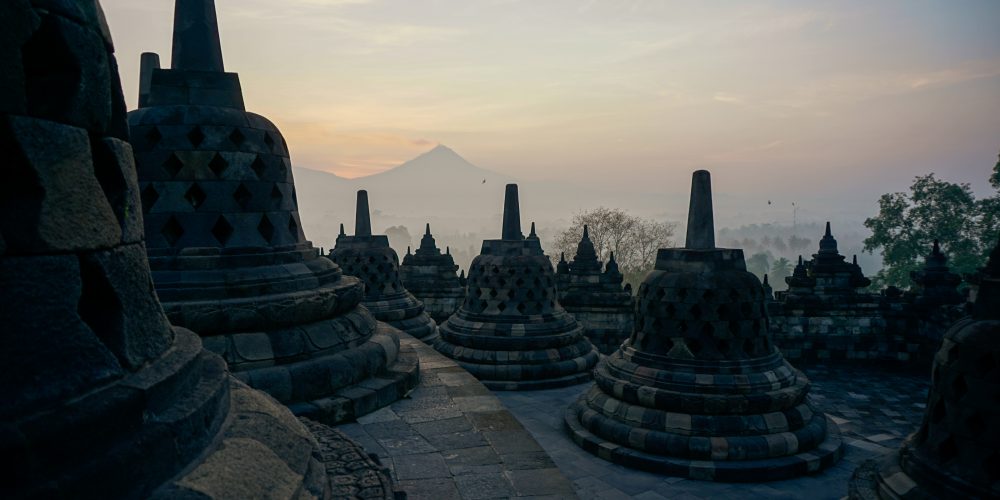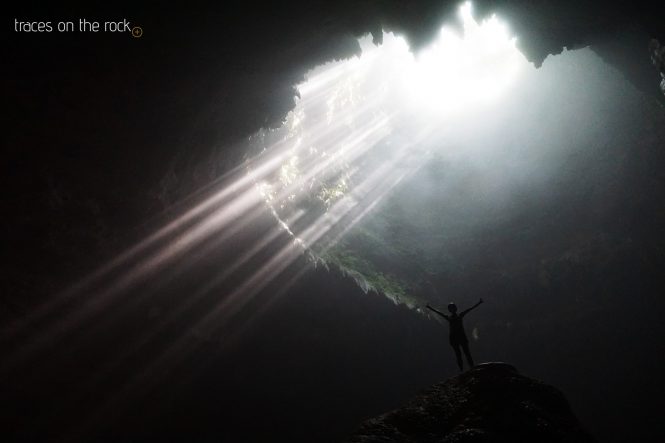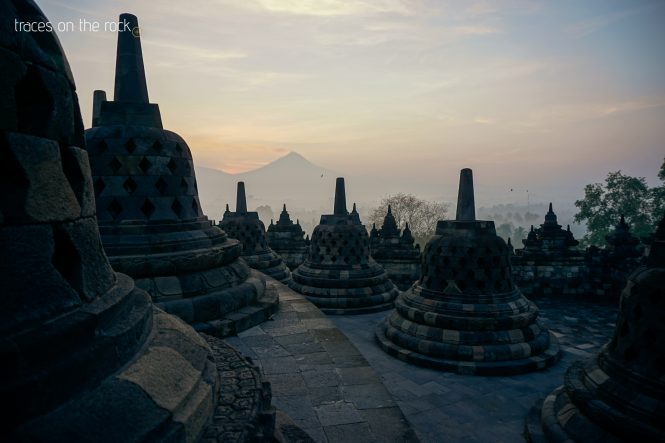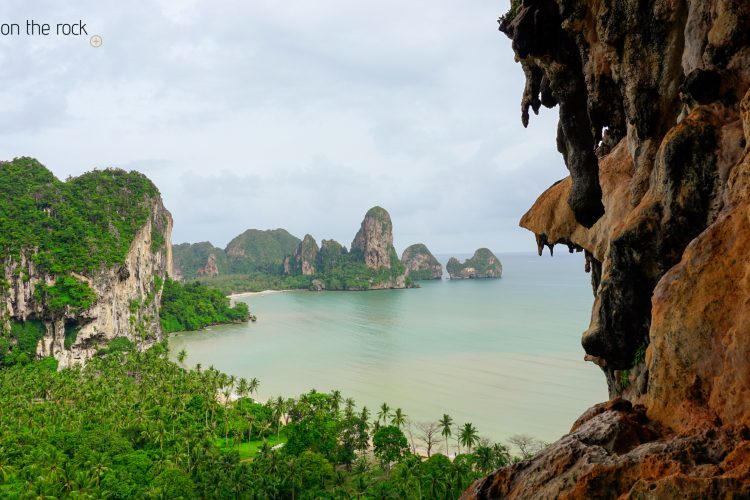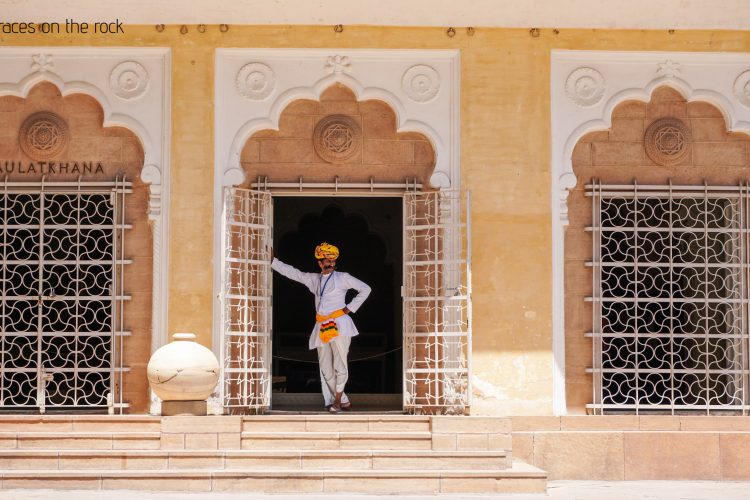Southeast Asia’s largest Buddhist temple
Borobudur is not a legendary figure from mythology but the largest Buddhist temple complex in Southeast Asia (Mahayana Buddhism). It is located near the volcano Merapi on the Indonesian island of Java. It was built during the Sailendra Dynasty (760-860, Sailendra means “ruler of the mountains”). The building is considered a manifestation of their power. Shortly after its completion, however, the temple was abandoned, as the Sailendra relocated their government seat to another part of the island for unknown reasons. It was therefore forgotten and due to the political power shifts in the country went into oblivion. Only in the 18th century was the plant “rediscovered”. Sir Thomas Stamford Raffles (1781 – 1826), a British explorer, statesman and founder of Singapore, was appointed Governor of Java in 1811 following the successful invasion of Java by the British. In this function he heard about the existence of Borobudur and commissioned the Dutch engineer H.C. Cornelius exploring the temple and excavating them from the ashes and vegetation. When the Dutch in 1835 conquered Java from the British, they took over the further excavations of the temple complex.
To visit Borobudur at sunrise is especially worth seeing. At four o’clock in the morning I went by scooter from Yogyakarta to the sightseeing spot around 30 km outside of Yogyakarta. It was freezing cold and the streets were unlit. When I arrived at the entrance to the temple complex, a dozen other visitors were already waiting. A large part traveled by coach as a group. When the gates were opened at five o’clock, there was also a push and a jostle. Armed with flashlights, some ran up the step pyramid as quickly as possible to get the best sunrise spot. When the sun rised over the volcano Merapi the sky was shrouded in a golden light. Borobudur rose magnanimously over the surrounding forest, which lie peacefully in front of us in the haze and fog of the night. I stood on the top terraces with its 72 perforated stupas containing small Buddha statues. Slowly the light lit up the grand architecture of the temple complex, which towered above everything. It’s hard to imagine how burdensome the construction must have been in the 9th century and how much effort must have been put into ridding it of earth, ash and jungle vegetation.
The base of the nine-step pyramid is more than 120m long. While the first six platforms still follow the square shape and become smaller towards the top, the top three platforms are round. Here are the famouse 72 perforated stupas situated. A large stupa builts the top of the temple. Borobudur’s balustrades display Buddhist symbols and depict Buddhist cosmology, in which the universe is divided into three worlds. In total, there are over 2672 reliefs depicting Buddha’s teachings and life as well as sutras or decorative features. In addition, visitors can visit 504 Buddha statues in Borobudur. Just like Borobudur, Prambanan, Indonesia’s largest Hindu temple complex, is a UNESCO World Heritage Site. Prambanan is located just a few miles east of Yogyakarta.
Indonesia’s largest Hindu temple
The architecture of Prambanan differs significantly from the Borobudur, although both temples were built at around the same time around 850. Historians speculate that the construction of the Hindu Sanjaya dynasty may be understood as a demonstration of power and as an answer to the construction of Borodudur by the Sailendra dynasty. The plant has eight main shrines and about 250 individual temples or shrines. The pointed architecture is characteristic of Hindu buildings. The largest shrines are dedicated to the gods Shiva (the Destroyer), Vishnu (the Keeper) and Brahma (the Creator). Prambanan suffered a similar fate as Borobudur. After completion, this temple was abandoned and disintegrated. His “rediscovery” by Colin Mackenzies was also under Sir Thomas Stamford Raffles occupation also. In 1918 the Dutch started a half-hearted reconstruction. Unfortunately, the temple fell victim to looting in the following years. Many sculptures were robbed or the stones used as building fabric. Only in 1930 began serious restoration work. These are still not completed. In some areas, large and small stone blocks, sculptures and stone carvings line up like a jigsaw puzzle, waiting to be put together.
Sulfur production at Kawah Ijen
But Java does not just have temples to offer. The island has countless volcanoes. I went to one of these volcanoes at night with the scooter. Kawah Ijen attracts with the fascinating Blue Fire – burning sulfur gases. This place is the most important sulfur accumulation in Indonesia. Since 1968, sulfur has been mined here.
Sulfur vapors are sent to an extraction point via a sophisticated pipe system, where the sulfur emerges in a liquid, orange-yellow form. When the sulfur is cooled and solidified, miners break sulfur slabs using iron poles . Later they carry the sulfur in reed baskets 3 km uphill to the crater rim and down into the valley. For each tour, they shoulder around 90 kg. The workers mine daily up to six tons, always accompanied by the glances and the camera of the tourists. At Kawah Ijen, visitors have the unique opportunity to observe miners working on sulfur extraction and admire the blue-burning sulfur gases. This spectacle is caused by overheating. When the sulfur gas ignites, it burns light blue and is especially at night a mystic-seeming natural spectacle.
Visiting this phenomenon is bearable only with gas mask. And even with this I find it difficult to breathe. Orange slices in the mask help against the gagging. Tourist would not dare to go to the mining site without a mask. Simple dust masks are absolutely useless here. On the spot, however, I see many miners without protective equipment. Some just hold a cloth or scarf over their mouth and nose. Again and again the winds in the volcano crater are turning and the highly toxic sulfur fumes make me squat and close my eyes. Breathing is particularly difficult. The locals also speak of the breath of Kawah Ijens. In these moments, I struggle with the desire to leave this place as soon as possible. But that is impossible, because I can not see one meter far. The job destroys the health of the miners. The wage is low. Nevertheless, the miners earn more money than on the surrounding plantations. The miners hope to earn extra money by selling carved figures made of sulfur. Very popular carvings are currently the Minions.
The sulfur is bought by the chemical industry and pharmaceutical companies. Even the sugar cane factories of the area use the sulfur for bleaching. Why? Because this sulfur is still cheaper than the one that is traded on the world market.
The sight of the blue fire is almost obsolete under these conditions. Individual flames flock wildly between the dense columns of smoke. I expect every moment the song of Rumpelstiltskin in my ear and a wild laugh. It is so inhospitable and so fascinating at the same time. The conditions to take a stunning photo are difficult. Again and again the winds turn and the flames disappear in the smoke. I gave up after half an hour and climbed up to the edge of the crater before dawn. Two strong sulfur miners with full baskets overtake me and disappeared in the fog and darkness.

